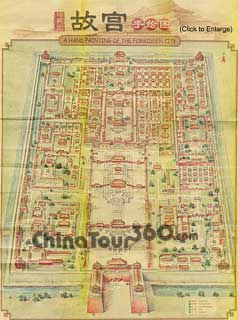East Route of Forbidden City: Zhongcui Palace - Jingyang Palace - Chengqian Palace - Yonghe Hall - Jingren Palace - Yanxi Palace - Zhai Palace - Fengxian Hall
From the Qiongyuan East Gate at the southeast corner of the imperial garden, you will get to the east part of the Forbidden City. There are many rich exhibitions of jade ware, gold and silver ware, bronze ware and clocks which represent the highest level of Chinese art. The East Route of Forbidden City tour takes about 1 hour's visiting time.
The first palace on your left is Zhongcui Palace, the residence of Ci'an. When Emperor Xianfeng passed away and Emperor Tongzhi acceded, there were two Empress Dowagers at the time, Cixi, the biological mother of Tongzhi and Ci'an, the empress of Xianfeng. Ci'an was a tempered person and did not approve Cixi's desire for power. In 1881, Ci'an died from a sudden illness after eating the snacks sent by Cixi. Considering her always healthy physical condition, it is said that she was actually poisoned by Cixi. After Ci'an's death, Cixi became the most powerful person in the whole country. Now Zhongcui Palace is an exhibition hall for precious and exquisite jade ware. Jade has a special place in Chinese culture and the carving crafts reached its summit in Emperor Qianlong years.
Jingyang Palace the Forbidden City is to the east of Zhongcui Palace. It is the storage for painting and calligraphy works in the Qing Dynasty and the museum for gold and silver ware now. Gold and silver ware plays very import roles in every aspect of Chinese people's lives. Ritual instruments, life utensils, ornaments and religious implement made by gold and silver are practical and beautiful.
Continue walking south, you will reach the Chengqian Palace and Yonghe Palace. Chengqian means to obey and follow the emperor's wishes and orders, and Yonghe means be harmonious and affectionate forever. They all express good wills to the royal family.
|
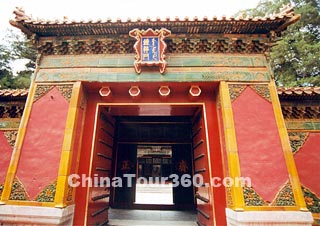
Gate of Zhongcui Palace
|
|
|

Delicate Bells
|
|
Bronze ware has a history of over 3,000 years in China. As the symbol of power and status, the ritual implement of merit record, bronze culture affected Chinese history a lot. It is a pity that the bronze ware exhibition in Chengqian Palace has been closed since May 10, 2010 because of redecoration of the hall.
Before the mercury mirror was imported, Chinese people had been using the copper mirror. Despite its normal function, it can also be an elegant adornment. More than 4,000 copper mirrors from the Warring States to the end of the Qing Dynasty have been collected in Yonghe Palace, and the ones for exhibition are unique and incomparable.
|
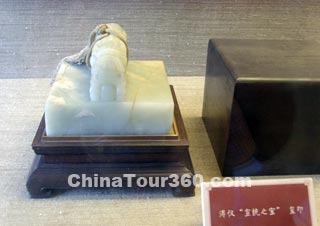
An Imperial Jade Seal
|
|
|
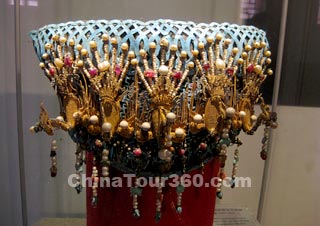
A Phoenix Coronet
|
|
The next two palaces of the Forbidden City are Jingren and Yanxi. The greatest emperor of the Qing Dynasty Kangxi was born in Jingren Palace in March, 1654. As the late Qing Dynasty was totally turbulent and the government was weak, many relics were taken out of the country because of the invasive war. Luckily some patriotic oversea Chinese have bought a part of the losing items back and donated them to the Forbidden City Museum. In the main hall of Jingren Palace, there is a huge rosewood screen carved with the names of over 700 donators. And their donations are showed here in turn.
Chinese porcelain has high reputation in the world. From September 22, 2010 to September 30, 2011, the exhibition of the rare Kuanyao Porcelain of the Song Dynasty is being held in Yanxi Palace. According to the archaeological validation, the origin of porcelain is in China, but the accurate time remains controversial. The kaolin colored glaze vessels from the Shang Dynasty excavated in Zhengzhou was the earliest known porcelain in the world. The Kuanyao in Song Dynasty was operated by the government and its products were only to be offered to the royal family. Even the waste products would be destroyed, that is why the ones that have been preserved until now are so valuable.
|
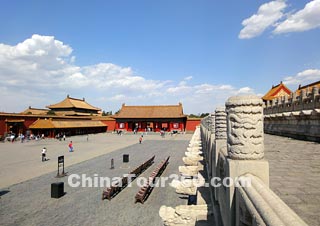
Fengxian Hall
|
|
|

Jingren Palace
|
|
The last two in East Route of Forbidden City tour are Zhai Palace and Fengxian Hall. In the old times, before the royal fete to heaven and the earth, the emperor needed to fast for a certain time. Zhai Palace is where the fast was held since Emperor Yongzheng, and during which time, feast, alcohol, meat and woman were all not allowed to show the devoutness. Fengxian Hall was the royal family temple and also where the ancestor worships were taken place. Now it is used as the exhibition hall for clocks made in the 18th century. Chinese people used sundial, hour glass and clepsydrato to mark the time before the European mechanical watches were imported at the beginning of the Qing Dynasty. Because of the convenience, variety of styles and means of time alarming, the clock displaced the traditional timepieces gradually. Everyday at 11:00 and 14:00, the staff at the exhibition will activate some of the clocks to show their interesting ways of time alarming.
If you have another one hour, you can add Outer East Route of Forbidden City tour in your trip. The architectural complex was built by Emperor Qianlong for his retired life.
